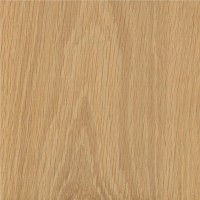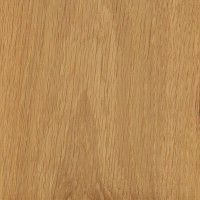 |
Common Name(s): Sessile Oak
Scientific Name: Quercus petraea Distribution: Most of Europe, to Asia Minor Tree Size: 80-115 ft (24-35 m) tall, 3-5 ft (1-1.5 m) trunk diameter Average Dried Weight: 44 lbs/ft3 (710 kg/m3) Specific Gravity (Basic, 12% MC): .57, .71 Janka Hardness: 1,120 lbf (4,990 N) Modulus of Rupture: 14,080 lbf/in2 (97.1 MPa) Elastic Modulus: 1,518,000 lbf/in2 (10.47 GPa) Crushing Strength: 6,860 lbf/in2 (47.3 MPa) Shrinkage:Radial: 4.5%, Tangential: 9.7%, Volumetric: 14.2%, T/R Ratio: 2.2 |
Color/Appearance: Has a medium yellowish-brown color, though there can be a fair amount of variation in color.
Grain/Texture: Has medium-to-large pores and a fairly coarse grain. May have irregular or interlocked grain depending on growing conditions of the tree.
Rot Resistance: Sessile Oak has been rated as having very good resistance to decay, and is commonly used in boatbuilding applications.
Workability: Easy to glue, and takes stain and finishes very well.
Odor: Has a tell-tale smell that is common to most oaks. Most find it appealing.
Allergies/Toxicity: Although severe reactions are quite uncommon, oak has been reported as a sensitizer. Usually most common reactions simply include eye and skin irritation, as well as asthma-like symptoms. See the articles Wood Allergies and Toxicity and Wood Dust Safety for more information.
Pricing/Availability: Widely grown and available in Europe, Sessile Oak is not seen nearly as commonly in the United States, and would be considered an imported lumber. Moderately inexpensive if purchased in an area where it grows locally, (i.e., Europe).
Sustainability: This wood species is not listed in the CITES Appendices or on the IUCN Red List of Threatened Species.
Common Uses: Cabinetry, furniture, interior trim, flooring, boatbuilding, barrels, and veneer.
Comments: Sessile Oak falls into the white oak group, and shares many of the same traits as White Oak (Quercus alba). The species is nearly identical to English Oak (Quercus robor), and is used extensively for both interior and exterior building applications throughout Europe.
- Black Oak (Quercus velutina)
- Bog Oak
- Brown Oak
- Bur Oak (Quercus macrocarpa)
- California Black Oak (Quercus kelloggii)
- Cherrybark Oak (Quercus pagoda)
- Chestnut Oak (Quercus prinus)
- English Oak (Quercus robur)
- Holm Oak (Quercus ilex)
- Japanese Oak (Quercus mongolica)
- Laurel Oak (Quercus laurifolia)
- Live Oak (Quercus virginiana)
- Oregon White Oak (Quercus garryana)
- Overcup Oak (Quercus lyrata)
- Pin Oak (Quercus palustris)
- Post Oak (Quercus stellata)
- Red Oak (Quercus rubra)
- Scarlet Oak (Quercus coccinea)
- Shumard Oak (Quercus shumardii)
- Southern Red Oak (Quercus falcata)
- Swamp Chestnut Oak (Quercus michauxii)
- Swamp White Oak (Quercus bicolor)
- Turkey Oak (Quercus cerris)
- Water Oak (Quercus nigra)
- White Oak (Quercus alba)
- Willow Oak (Quercus phellos)
Scans/Pictures: There are currently no pictures of this exact wood species, but a similar species within the White Oak grouping is being substituted (Q. alba). If you’d like to contribute a wood sample of this specific species to be scanned, (even small pieces of veneer can be sent), please use the contact form.
 |
 |





Extensively carved throughout Northern Europe.